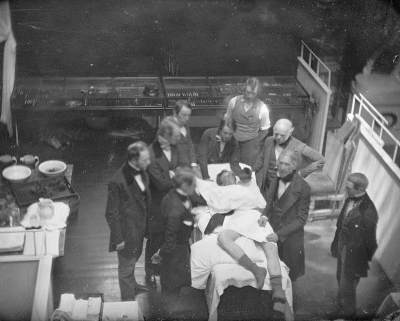
The modern anaesthetic era is only just over a hundred and sixty years old. Successful anaesthesia for surgery was first demonstrated in 1846. Before that, the few operations that were possible were carried out either with no pain relief or after a dose of opium and/or alcohol.
There were many attempts to relieve pain throughout the centuries. Early examples include loss of consciousness produced by blows to the patient’s head or by compression of the carotid arteries (in the neck). In the Middle Ages, elaborate potions included alcohol and various plant extracts, such as mandrake root. Opium was widely used, particularly in China, and the first intravenous injection of opium was made in the 1660’s. Pain relief in an arm or a leg was produced by squeezing the nerves in the upper part of the limb and also by applying cold water, ice, or snow. Hypnotism became popular as a means of pain relief and medical treatment during the late eighteenth and early nineteenth centuries.
The seventeenth and eighteenth centuries were marked by a rapid increase in knowledge of how the heart and lungs worked, as well as the properties of many gases. In 1799, Sir Humphrey Davy suggested the use of nitrous oxide to produce pain relief. Twenty-five years later, Dr Henry Hickman described the use of carbon dioxide to produce loss of consciousness, while Horace Wells first used nitrous oxide for extraction of teeth in 1844.
Although Paracelsus described the effects of ether on animals in 1540, the first use of this drug for general anaesthesia in humans was in 1842 by Drs Long and Clark. On 16 October 1846, Dr William Morton gave the first public demonstration of ether anaesthesia in Boston. (The operating room where this occurred, known as the Ether Dome, is preserved intact at the Massachusetts General Hospital.) This major advance in the relief of human suffering spread rapidly, and the first use of ether in England and Scotland followed soon after. As the only means of communication was by ship, it took months for the news to reach many countries, and the first recorded anaesthetic in Australia was given in June, 1847.
A few weeks after the famous ether demonstration, Oliver Wendell Holmes popularized the word ‘anaesthesia’. He used the word to describe ‘insensibility – more particularly to objects of touch’, as produced by ether. The word had been used previously to describe simply any lack of feeling, for example, that due to a nerve problem. Holmes also introduced such combination of words as ‘anaesthetic state’ and ‘ anaesthetic agent’.
Professor James Young Simpson of Edinburgh introduced chloroform in 1847. He also described the first anaesthetic death in 1848, the patient being a young girl named Hannah Greener. She was the first of many who suffered sudden heart failure under chloroform. In London, John Snow led the way in analysing complications after anaesthesia and surgery, with a careful evaluation of postoperative deaths. He attempted to modify his practice by referring to what he had learned from previous cases.
Anaesthesia produced by nerve block, or regional anaesthesia, became possible after cocaine was isolated from the coca plant in 1860. Dr Karl Koller first produced anaesthesia of the skin and mucous membranes in 1884. In New York in 1885, Dr Corning gave the first spinal anaesthetic and then the first epidural anaesthetic in 1901.
General anaesthesia became more pleasant for patients when pentothal or sodium thiopentone came into use in the late 1930’s. Muscle relaxation using curare was first demonstrated in humans in Montreal in 1942, allowing a lighter depth of general anaesthesia than had previously been possible. In the 1950’s, the investigation of halogenated hydrocarbons as nonflammable, highly potent anaesthetic agents resulted in the introduction of halothane and the disappearance of ether and chloroform from most operating rooms.
Credit : Australian Society of Anaesthetists
Picture Credit : Google




